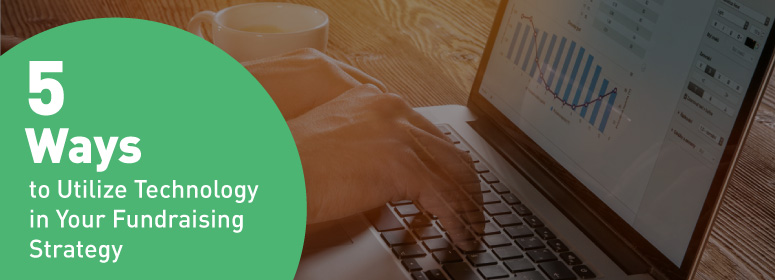Fundraising can be a stressful endeavor. After all, you need to find potential donors, perform outreach, and track each step and contribution as closely as possible. But, it doesn’t have to be as stressful as it seems. In fact, with the right technology, you can make each part of your fundraising strategy easier to perform and monitor.
There are many ways to engage your donors, but without leveraging the right tools, this becomes harder to achieve. Technology can help in a variety of ways for a variety of campaigns, so do your research and decide what tools are right for you and your organization.
In this article, we’ll discuss the following areas where technology can help streamline your process:
- Prospect research
- Donor organization
- Matching gifts
- Peer-to-peer fundraising
- Communication
All of these areas of fundraising can be improved with software and other tools. Are you ready to explore these strategies and apply them to your own fundraising methods? Let’s dive in!
Related reading: 52 Proven Nonprofit Fundraising Ideas
1. Prospect research
A good start to your nonprofit fundraising strategy is performing prospect research, which the right technology can help streamline. But first, let’s define prospect research.
Prospect research is a technique that nonprofits use to learn more about potential or existing donors, such as their personal backgrounds, giving histories, wealth indicators, and philanthropic motivations. This helps determine the prospect’s ability to give and their affinity toward an organization.
Information used in prospect research includes:
- Previous donations to your nonprofit. Have they donated to your nonprofit before? This is a clear indication that they are more likely to donate in the future.
- Donations to other nonprofits. This indicates an individual’s charitable habits overall.
- Personal interests and hobbies. This information can be drawn from public social media profiles and is useful in determining your prospects’ philanthropic interests.
- Real estate ownership. Individuals who own higher-valued real estate are more likely to give philanthropically than individuals who don’t.
- Business affiliations. This can also help determine wealth by gathering information on an individual’s career.
- Political giving. If an individual has donated large sums of money to political campaigns, that’s an indication that they have the financial ability to donate a major gift.
So, where does technology come into play? There is software available that can help streamline your prospect research process. By using a resource like DonorSearch’s prospect research tool, you can more efficiently compile your research and even integrate it into your CRM database.
Using technology to obtain information about your prospects is key to a successful fundraising strategy. Without a consistent method of compiling and recording information, you could quickly become overwhelmed with the data and use it less efficiently.
2. Donor organization
While prospect research is important, it’s also essential to keep all the data you retrieve organized once you have it. That’s where a CRM database comes into play. A CRM database, or donor database, helps you compile important information about individual donors.
Having a CRM database helps you personalize your outreach, especially if you’re reaching out to potential major donors. However, there are core features to keep in mind as you look around for this software.
The most important features of a CRM include:
- Donor profiles. You should be able to track all the important information about a donor, from their name and address to their involvement with your nonprofit. This is key to personalizing your communications with them.
- Email automation. Using the email addresses on file, your CRM software should send out automated emails to your constituents, and you should also be able to customize those emails to your brand.
- Data reports. Having the ability to generate several reports, especially custom reports unique to your organization, is also a key feature. This could include fiscal activity and individual donor engagement.
- Segmentation. You should be able to segment your donor list so that you can organize them by different qualifiers, such as age, demographic, education, and more.
By using using nonprofit CRMs, you can streamline your process and keep all of your donor data organized. This is imperative if you want to make successful fundraising asks and cultivate meaningful relationships with your donors.
3. Matching gifts
One element of fundraising that can often be overlooked is matching gifts. Matching gifts occur when a company agrees to match their employees’ charitable donations. It’s advisable that you promote matching gifts to your donors because doing so can lead to a spike in the contributions you receive.
There are several advantages to promoting matching gifts into your fundraising strategy, such as:
- Increased contributions. Donors are more likely to contribute to a nonprofit or cause if they know their donation will be matched. Part of this is due to the feeling that their donation has a greater impact than it would otherwise, and that they can make a difference.
- Increased frequency. Donors might also contribute more often if they know every gift will be matched by their employer. So they may donate throughout the year, rather than just once or twice.
- Increased contribution amounts. Donors are more likely to increase their initial donation amount because they know doing so in conjunction with a gift match will increase the amount overall.
Technology can help with this! By incorporating a matching gift database into your nonprofit’s website, donors can search for their employer to determine if their gift will be matched, which increases your chances of receiving a donation, potentially in a higher amount.
Learn more about matching gifts here.
4. Peer-to-peer fundraising
Peer-to-peer fundraising is a great strategy to use because it elevates your campaign to a social level, which widens your outreach. Through peer-to-peer fundraising, nonprofits call on volunteer fundraisers to raise money on their behalf by creating their own individual campaign pages.
So, how does it work? In a peer-to-peer fundraising campaign:
- The nonprofit sets its goals.
- The nonprofit chooses a peer-to-peer fundraising platform.
- The nonprofit recruits volunteer fundraisers and instructs them on how to run their campaign pages.
- The volunteers create and share their personal campaign pages.
- The nonprofit tracks the performance, plans engaging events to keep up the energy, and manages the campaign overall.
Technology streamlines all of this. By using a peer-to-peer fundraising platform, you can create your main fundraising campaign page, and from there, the individual volunteers’ fundraising pages will branch off. This is also an effective method to increase your fundraising success because you’re putting a familiar face to a cause for many donors, which will encourage them to contribute.
Looking for more information about this fundraising method and the platforms you can use? Double the Donation offers helpful information about peer-to-peer fundraising.
5. Communication
Sometimes we’re so focused on other elements of fundraising that we forget about the key piece: communication. How you specifically communicate with donors is essential to your fundraising strategy.
You want donors to feel like they can make an impact, but you also want to personalize your outreach and ensure they feel appreciated at the conclusion of each campaign. By showing appreciation and personalizing your conversations with donors, you’re demonstrating that your goal is to create a relationship, not just ask for contributions.
Here are ways communication can play a large role in your fundraising:
Social media. When you leverage your CRM database to determine particular age groups and preferred methods of communication, you might find that much of your donors like to use social media. This is great in that you can reach out on multiple platforms, but you should also be strategic about it.
Create meaningful content that’s not just about you, but who you’re helping. Utilize several platforms so you don’t limit your audience to just Facebook or Instagram, for example, and track how successful your posts are so you can adjust your strategy if necessary.
Email. Use your CRM’s email database to your advantage and reach out to donors via email. Share your story and your goal, and track the open-rates and CTRs (click-through-rates) to your donation page. Email is a great way to reach many people in a consolidated effort.
As mentioned earlier, a robust CRM database should also allow you to automate emails. For example, immediately send out thank-you acknowledgments when your donors make a contribution, which helps them for tax recording purposes and will make them feel appreciated.
Text messaging. People are more inclined to form relationships over one to one conversations than over passive communication channels. Use your CRM to segment your mobile subscribers and send them a personal event invite or details about your next fundraising campaign. Send out general alerts and reminders as a single broadcast while event invites and fundraising appeals should be part of a peer to peer texting campaign. A staffer or volunteer engages supporters in personal conversations and makes the donation appeal, with all data syncing back to the CRM.
Direct mail. Your CRM database can even help with direct mail outreach. Set up a general letter template and use your CRM to save the template, auto-populate the donor’s name, and auto-generate mail labels from your donor lists. This streamlines the mailing process and will help you reach donors who prefer direct mail outreach.
Promoting fundraising events and campaigns in general can feel stressful, but it doesn’t have to be with the right tools and technology. By taking advantage of effective communication methods for the appropriate individuals, you can confidently reach out and make successful fundraising asks.
By leveraging technology, you can elevate your approach to fundraising and make each process simpler and easier to track. If you use the right software to perform prospect research, organize your data, and reach out to constituents, you’ll have a more effective outreach plan and bring in a greater amount of contributions.
It’s important to avoid certain mistakes when building donor loyalty, such as not thanking them or not focusing on building relationships, and technology can help you accomplish it all. What are you waiting for? Try out these strategies for yourself!
Author: Adam Weinger
Adam Weinger is one of the leading experts on corporate giving programs.
He’s the President of Double the Donation, a company which helps organizations raise more money from employee matching gift and volunteer grant programs. The company partners with nonprofits ranging from arts and cultural organizations, hospitals, educational institutions, and community-based organizations to help them increase fundraising from corporate giving programs.






